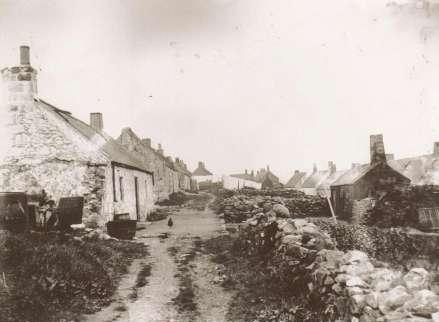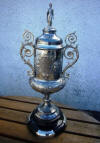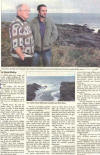
Sea Angling |
Downies resident Arthur Bruce proves that an old bamboo rod was all that you needed to land a good catch from the nearby rocks in the 1960's.
An illustration of the dangers of Sea Angling at Old Portlethen.
 Over recent years
Angling has become a very popular sport around the Portlethen area and
fishers can be seen dotted around the coastline on a regular basis
throughout the year. Hardcore Anglers have also been known to fish this
coast overnight and Iíve often looked out from my living room window on
a cold January evening around midnight and seen the telltale sign of two
or three night lanterns indicating their fishing locations.
Over recent years
Angling has become a very popular sport around the Portlethen area and
fishers can be seen dotted around the coastline on a regular basis
throughout the year. Hardcore Anglers have also been known to fish this
coast overnight and Iíve often looked out from my living room window on
a cold January evening around midnight and seen the telltale sign of two
or three night lanterns indicating their fishing locations.
Any Sea Angler reading this section is going to know a lot more about this sport than I ever will so the information included here will be of the most basic nature. My limited knowledge is down to the occasional fishing stint I did with an old bamboo rod back in the 1970ís and conversations that Iíve had with Anglers when Iíve talked to them whilst doing my creels in the summer months.
The
most common fish to be had on our coast are cod, usually a ďwearieĒ or
rock cod which has a redder tint to itís colouring than the more regular
deep sea cod. Additionally we have Pollock, which are locally known as
liathe and Coalfish, more commonly known as saithe. The one other fish
that you may catch is the mackerel, these seasonal fish are most
commonly found during the months of July and August although Iíve
noticed them appearing earlier in the season and Iíve caught quite a few
on the hand line whilst fishing from a boat in June. These are not the
only fish that can be caught from the rocks but they are the most common
ones and anything caught out with this foursome is likely to be a
one-off.
these seasonal fish are most
commonly found during the months of July and August although Iíve
noticed them appearing earlier in the season and Iíve caught quite a few
on the hand line whilst fishing from a boat in June. These are not the
only fish that can be caught from the rocks but they are the most common
ones and anything caught out with this foursome is likely to be a
one-off.
The usual baits used by Anglers are mussel, lug, rag, squid, mackerel and crab. Jelly lures can be used too and are generally quite successful when fishing in a boat 400 yards offshore and I imagine they would work similarly when fishing from the rocks. When the mackerel season is on and they are in the vicinity you can take as many as six at a time with fly feathers and they will generally take at any depth, equally likely to be caught near the surface as the seabed.
One of the most important factors to be aware of when fishing our coast is the weather and tides. Most of the fishing marks on our coast are very exposed to the elements and conditions can change dramatically in a short space of time, this is borne out by the fact that, in recent years, there has been loss of life in this area as well as a few narrow escapes where people have been lucky to escape with their lives. If in doubt about the state of the sea stand well back and observe conditions for fifteen minutes before going near the waters edge and making that first cast. Also any Angler should be aware whether the tide is flooding or ebbing before they get to their preferred mark.
The common fishing marks in our area are the Ship's Stern and Saltpan (more commonly known as the Bothy) immediately to the east of Portlethen Shore. Another mark which used to be quite popular with locals villagers in the recent past is the Land Crag, a tidal promontory just east of the Saltpan and about two hundred yards south of the Ship's Stern.
 There are other marks nearby such as
Tamís Chair which is equidistant
between Black Slough and Peel Slough and I believe that the stretch of
rocks running westward from Findon Ness is popular too although Iím
afraid that I donít know exactly where the best spots are on this
stretch of coastline. The problem with Findon Ness is that the
predominant local weather is from the south so conditions can be far
from perfect when you get to the waterís edge, even on a fine day. The
other problem with this area is the climb to get to and from the waters
edge because there are quite a few inaccessible cliffs at various points
along the Ness. Donít forget that navigating the Moss at Findon Ness to
get to and from your destination can be quite a challenge too Ė some of
these tracks leading through the Moss will lead you into boggy ponds!
There are other marks nearby such as
Tamís Chair which is equidistant
between Black Slough and Peel Slough and I believe that the stretch of
rocks running westward from Findon Ness is popular too although Iím
afraid that I donít know exactly where the best spots are on this
stretch of coastline. The problem with Findon Ness is that the
predominant local weather is from the south so conditions can be far
from perfect when you get to the waterís edge, even on a fine day. The
other problem with this area is the climb to get to and from the waters
edge because there are quite a few inaccessible cliffs at various points
along the Ness. Donít forget that navigating the Moss at Findon Ness to
get to and from your destination can be quite a challenge too Ė some of
these tracks leading through the Moss will lead you into boggy ponds!
The rocks around Downies are probably more accessible although itís still a fair climb to get from the shore head to the waterís edge. I have seen Anglers fishing the rocks near Strathfresh, and more specifically at Through Gang Point. At this location there used to be a rope anchored at the top of the cliff to aid Anglers navigate the steep gradient found there. This is the area where I used to see a lot of night lights although I havenít seen anyone fishing there for a long time, possibly on account of the long walk and climb (this spot is halfway between Downies and Old Portlethen).
Nearer to Downies itself I have watched individuals fishing marks to the north of the Knaps of Downies (right next to one of my creels) and Iíve seen catches of three or four cod being taken there over the course of the morning. ďThe BanksĒ at the opposite end of Cammachmore appears to be popular although I donít know how successful the catches are, however there must be something there because the Anglers do return time and again.
South of Downies there is Berrymuir Head and continuing southwards from that point there appears to be a selection of different marks that are fished regularly. Once again I have no idea which marks are the best in this area but there must be something there because itís a popular area and there appear to be Anglers around most weekends.
There could yet be a great mark still waiting to be discovered and it might be useful to have a look at the ďRocks and SloughsĒ page where there is a large selection of every major coastal landmark between Findon Ness and Berrymuir Head (a distance of approximately two miles).
In my youth Angling was a solitary sport, and usually only practised by local villagers when there was a need to put some food in the pantry. Occasionally a ďtravellerĒ from Aberdeen might appear to do a spot of fishing but these visits were far from frequent. In recent years Anglers arrive from everywhere and itís not unusual to find people who have travelled from Glasgow, Edinburgh, and all points near and far such is the popularity of the sport nowadays.
There was a point in the past where the sport of Sea Angling was equally popular, if not more so, than it is today and it was in these times that the rocks on our coast would have been quite crowded. The late 1800ís and the early portion of the 1900ís was the peak period when Angling was at its most popular and not only were our coasts crowded with individuals doing a spot of rock fishing but one particular team event became very popular with spectators as well.
 It
was during this period of time that the Douglas Cup was introduced and
teams from around the local villages competed in an annual event to see
who could catch the most fish. Unfortunately Iím not in the position to
define the history of the event, what the rules were, and I have no idea
who ďDouglasĒ was that the trophy was named after. What I do know was
that local villages and fishing clubs participated in the event which
lasted from 1896 through to 1921.
It
was during this period of time that the Douglas Cup was introduced and
teams from around the local villages competed in an annual event to see
who could catch the most fish. Unfortunately Iím not in the position to
define the history of the event, what the rules were, and I have no idea
who ďDouglasĒ was that the trophy was named after. What I do know was
that local villages and fishing clubs participated in the event which
lasted from 1896 through to 1921.
 Itís
possible to know which teams participated in the competition by looking
at the list of winners that are stamped on the base of the trophy
although itís quite probable that there were other additional teams
taking part who never actually won the event.
Itís
possible to know which teams participated in the competition by looking
at the list of winners that are stamped on the base of the trophy
although itís quite probable that there were other additional teams
taking part who never actually won the event.
The winners of the first competition which took part in 1896 were Muchalls and they later repeated their initial triumph in 1909, 1912, 1916, 1918 and 1920.
Portlethen had their first success in 1897 and there were further wins for them in 1902, 1903, 1904, 1905 and 1907.
Newtonhill enjoyed their one and only triumph in 1898.
Cove, who were ultimately the most successful fishing team, won the trophy in 1899, 1906, 1908, 1910, 1913, 1917, 1919 and 1921.
In addition to these teams, which were named after local villages there was a series of wins for other teams or clubs that had no place name association. The B Team won the trophy in 1900, Wednesday Team won it in 1901 and 1911, W. Pritchardís Team won it in 1914 and W. Roses Team won in 1915.
For those interested in statistics the largest catch was made in 1919 by the Cove Team. Since this catch weighed in at 1035 pounds itís probably safe to make the assumption that the competition took place over a period of time rather than one day.
The last trophy was fished for in 1921 and won by Cove and it would have made sense that, as the most frequent and final winners of the competition, the trophy would have remained in the community of Cove.
 That
wasnít the case and the trophy's final resting place is Portlethen
Village and if you would like to see the Douglas Cup today, you can
still see it sitting in the bar at the Neuk. Also in the Neuk there is a
picture, on the wall of the bar next to the trophy, of the 1897 winning
team from Portlethen.
That
wasnít the case and the trophy's final resting place is Portlethen
Village and if you would like to see the Douglas Cup today, you can
still see it sitting in the bar at the Neuk. Also in the Neuk there is a
picture, on the wall of the bar next to the trophy, of the 1897 winning
team from Portlethen.
_small.jpg)
